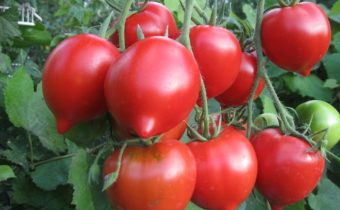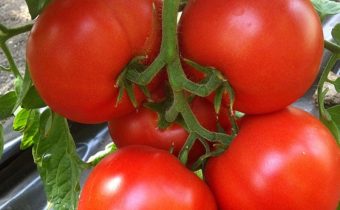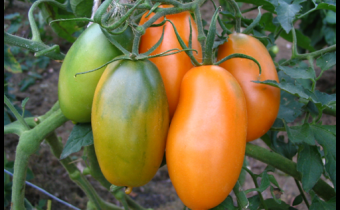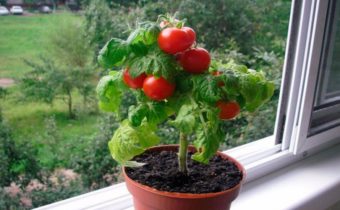Tomato Strawberry dessert: unpretentious with great taste
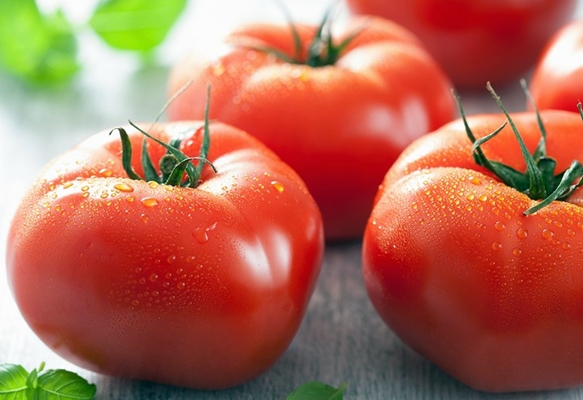
Very often, the summer resident in the selection of varieties for the new season has to make a choice between the taste of the selected variety and its yield or resistance to diseases. The ideal variety is difficult to pick up, especially since the quality of the fruit is affected by the growing conditions and the quality of the care of the plant.
One of the tomatoes, which according to the characteristics and description of the variety belongs to the most harmonious, is the tomato "Strawberry dessert". Unfortunately, a small amount of reviews, even in the presence of a photo of a plant, does not make it possible to accurately estimate its yield.
Variety refers to the indeterminate (with unlimited growth point), mid-ripening tomatoes. Recommended for growing in greenhouses, where the ripening period of fruit is stretched in time.
The main thing about tomato
 The bushes of this plant are quite powerful, in a greenhouse they reach a height of 1.8 m. For large fruits, the bush is formed in 1-2 stems, be sure to stepchild, the lower leaves are pruned.
The bushes of this plant are quite powerful, in a greenhouse they reach a height of 1.8 m. For large fruits, the bush is formed in 1-2 stems, be sure to stepchild, the lower leaves are pruned.
Growing in strawberry tomatoes in greenhouses allows you to extend the period of fruiting. When the autumn cold snap approaches, the tops on the bushes are pinched, leaving two leaves after the last brush.
Tomatoes of this variety have a great taste, justifying the name of the tomato, and have the following features:
- Fruits are sweet, juicy pulp, thin skin.
- Fruit weight reaches 300g.
- When ripe, the color of the tomatoes becomes rich red.
- Used for making salads, juices, as well as ketchups, tomato paste.
- Productivity - up to 10 kg from a bush.
See also: Description varieties tomato "Batyanya"
Diseases and pests
The variety is resistant to most diseases of tomatoes, but is affected by late blight, although to a lesser extent compared to other varieties.
Planting in a greenhouse often increases the likelihood of some viral and fungal diseases, so when using a greenhouse for growing tomatoes it is recommended:
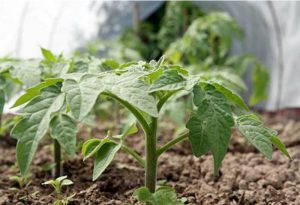
- Regularly treat the greenhouse walls, inventory and soil with disinfectant solutions, preferably in the fall, immediately after harvesting.
- When growing seedlings, use seeds and soil that have undergone disinfection.
- For the prevention of viral and fungal infections of plants to process during the growing season with copper-containing preparations or Fitosporin.
To combat the wireworm and the larva of the Maybug, only digging the land is an effective means, otherwise they can only be detected when the plants are irreparably damaged. In case of mass infection with wireworm, it is recommended to treat the soil with Bazudin.
To combat land pests, there are a large number of entericidal preparations available, but their use in small greenhouses is not always advisable. Summer residents prefer the use of folk remedies - decoctions of wormwood, tincture of garlic, bitter pepper, mixed with liquid laundry soap.
To scare the Colorado beetles used birch tar soap solution.Colorado beetles can cause significant harm to young plantings of tomatoes in a greenhouse, if they are not collected in time and prevent the appearance of larvae.
Main advantages and disadvantages
 Most vegetable growers who grew up a strawberry dessert tomato give a characteristic and description of the variety as extremely unpretentious, disease-resistant, and having excellent taste qualities.
Most vegetable growers who grew up a strawberry dessert tomato give a characteristic and description of the variety as extremely unpretentious, disease-resistant, and having excellent taste qualities.
One of the advantages of the variety when grown in greenhouses, is the extended period of fruiting, as the fruits ripen over the entire height of the stem gradually.
The disadvantages of the variety include the need to form, cradle and garter tomatoes to the trellis, which takes a lot of time to care for the plants.
See also: Why do tomato leaves turn yellow in the greenhouse and how to deal with it?
Features of plant care
Seed preparation before planting includes the following steps:
- Seed treatment in disinfectant solutions of potassium permanganate or Fitosporin for 20 minutes.
- Rinse in running water.
- Immersion in growth stimulant solutions, trace elements for 5-6 hours.
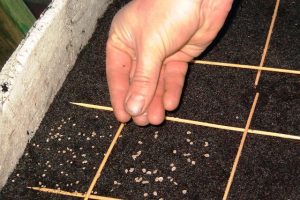 The land for growing seedlings is prepared from a mixture of garden soil with biohumus, mineral fertilizers, and ash; it should be light and breathable. If the garden soil is clay and heavy, add peat or coconut substrate to the mixture.
The land for growing seedlings is prepared from a mixture of garden soil with biohumus, mineral fertilizers, and ash; it should be light and breathable. If the garden soil is clay and heavy, add peat or coconut substrate to the mixture.
Sowing is done in moist soil with treated seeds. They are laid out on the surface of the earth in 2-3 cm, sprinkled on top with a layer of earth (0.5 cm), slightly compacted and tightly, but not tightly closed with a film or paper. Rice boxes clean in a warm place.
Plants hatch in 3-4 days. When loops appear, the boxes are placed on window sills or under fluorescent lamps. It is important to ensure maximum coverage for at least 12 hours a day.
After the appearance of two true leaves, plants are planted in separate containers or more spacious boxes, with a distance of at least 15 cm between them. In the process of growth, seedlings are watered and fed with fertilizer for seedlings 1-2 times over the entire period.
Since the tomato variety “Strawberry dessert” is intended mainly for growing in greenhouses, the land is prepared in advance, usually in the fall. In the spring, compost and mineral fertilizers are introduced into the soil.
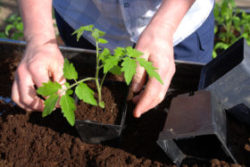 Plants are planted when the threat of frost has passed, usually at the age of 50 -55 days.
Plants are planted when the threat of frost has passed, usually at the age of 50 -55 days.
The distance between the tomatoes when planting in a row - 40cm in the formation of one stem
Subsequent care includes watering the plants once a week, weeding, loosening, shaping and grading, pruning the lower leaves.
See also: Varieties of tomatoes for the greenhouse, resistant to phytophthora
Feedings are carried out before the formation of ovaries with nitrogen-containing fertilizers — herbal extract, or a solution of mullein infusion, then transferred to fertilizers with fertilizers containing phosphorus and potassium. Top dressing is carried out after watering the plants every 2-3 weeks.
These techniques will allow you to avoid tomatoes of various diseases and bear fruit for a long period, up to the cold.
Video: Caring for tomatoes. First important steps


